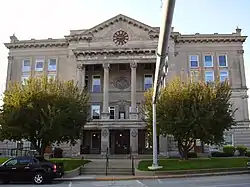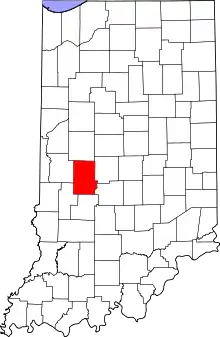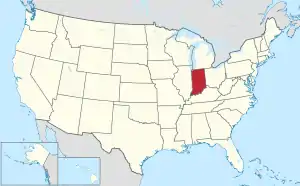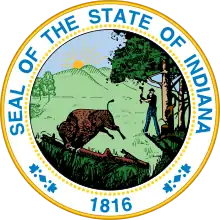Putnam County, Indiana
Putnam County is a county in the U.S. state of Indiana. As of the 2010 United States Census, the population was 37,963.[2] The county seat is Greencastle.[3] The county was named for Israel Putnam, a hero in the French and Indian War and a general in the American Revolutionary War. The county was created in 1821 and organized in April 1822.[4]
Putnam County | |
|---|---|
 Putnam County Courthouse in Greencastle | |
 Location within the U.S. state of Indiana | |
 Indiana's location within the U.S. | |
| Coordinates: 39°40′N 86°50′W | |
| Country | |
| State | |
| Founded | December 31, 1821 (created) April 1822 (organized)[1] |
| Named for | Israel Putnam |
| Seat | Greencastle |
| Largest city | Greencastle |
| Area | |
| • Total | 482.69 sq mi (1,250.2 km2) |
| • Land | 480.53 sq mi (1,244.6 km2) |
| • Water | 2.16 sq mi (5.6 km2) 0.45%% |
| Population | |
| • Estimate (2018) | 37,779 |
| • Density | 78.62/sq mi (30.36/km2) |
| Time zone | UTC−5 (Eastern) |
| • Summer (DST) | UTC−4 (EDT) |
| Congressional district | 4th |
| Website | co |
| Indiana county number 67 | |
Putnam County is included in the Indianapolis-Carmel-Anderson, IN Metropolitan Statistical Area.
History
After the American Revolutionary War established US sovereignty over the territory of the upper Midwest, the new federal government defined the Northwest Territory in 1787 which included the area of present-day Indiana. In 1800, Congress separated Ohio from the Northwest Territory, designating the rest of the land as the Indiana Territory. President Thomas Jefferson chose William Henry Harrison as the governor of the territory, and Vincennes was established as the future capital. After the Michigan Territory was separated and the Illinois Territory was formed, Indiana was reduced to its current size and geography. In late 1816, the Indiana Territory was admitted to the Union as a state, although much of its territory was still in dispute as to possession by Native Americans. The land containing Putnam County was brought into the possession and control of the United States by the Treaty of St. Mary's in 1818 (known as New Purchase).
The first county to be organized (1790) in the Northwest Territory was Knox, covering the western part of the future state, with its territory gradually reduced as pockets of settlement allowed the creation of smaller counties. After the Indiana Territory was admitted to the Union as a state on December 11, 1816, Sullivan (December 30, 1816), Vigo (January 21, 1818), and Daviess (February 2, 1818) counties were created, followed by Owen County on December 21, 1818. By 1821, the northern parts of Owen and Vigo counties were sufficiently settled to allow creation of a new county, which was authorized on December 21, 1821. Interim commissioners were named and tasked with organizing the county government, which they began in April 1822.[1]
The county's boundary was changed on February 12, 1825, when Clay County was created. It has retained its present configuration since that time.
Geography
The terrain of northern Putnam County is mostly flat; rolling hills become more evident in the center and southwest portions. At the time of settlement, the county was completely tree-covered (poplar, oak, walnut, maple, beech, and hickory),[1] but presently the flat portions have been cleared and used for agriculture; the drainage areas are still wooded.[5] Walnut Creek drains the east central part of the county, flowing south-southwestward into Owen County. Big Walnut Creek drains the upper part of the county, flowing southwestward into Parke County, where it is captured in the Cecil M Harden Lake. The highest point in the county (980 feet/299 meters ASL) is a gradual rise two miles (3.2 km) SW of Bainbridge.[6]
Limestone deposits were extracted beginning in the nineteenth century, and a large iron-ore vein southwest of Cloverdale was discovered in the 1860s.[1]
According to the 2010 census, the county has a total area of 482.69 square miles (1,250.2 km2), of which 480.53 square miles (1,244.6 km2) (or 99.55%) is land and 2.16 square miles (5.6 km2) (or 0.45%) is water.[7]
Adjacent counties
- Montgomery County - north
- Hendricks County - east
- Morgan County - southeast
- Owen County - south
- Clay County - southwest
- Parke County - west
Lakes
- Cagles Mill Lake (part)
- Glenn Flint Lake
- Heritage Lake[5]
Protected areas
- DePauw University Nature Park
- Fern Cliff Nature Preserve
- Lieber State Recreation Area[5]
Cities
- Greencastle (county seat)
Census-designated places
Unincorporated places
- Barnard
- Belle Union
- Blakesburg
- Brick Chapel
- Broad Park
- Brunerstown
- Cagle Mill
- Carpentersville
- Cary
- Clinton Falls
- Cradick Corner
- Edgewood Lake
- Fincastle
- Fox Ridge
- Groveland
- Hirt Corner
- Jenkinsville
- Keytsville
- Limedale
- Manhattan
- Morton
- Mount Meridian
- New Maysville
- Pleasant Gardens
- Portland Mills
- Putnamville
- Raab Crossroads
- Raccoon
- Reelsville
- Vivalia
- Westland
Townships
Climate and weather
| Greencastle, Indiana | ||||||||||||||||||||||||||||||||||||||||||||||||||||||||||||
|---|---|---|---|---|---|---|---|---|---|---|---|---|---|---|---|---|---|---|---|---|---|---|---|---|---|---|---|---|---|---|---|---|---|---|---|---|---|---|---|---|---|---|---|---|---|---|---|---|---|---|---|---|---|---|---|---|---|---|---|---|
| Climate chart (explanation) | ||||||||||||||||||||||||||||||||||||||||||||||||||||||||||||
| ||||||||||||||||||||||||||||||||||||||||||||||||||||||||||||
| ||||||||||||||||||||||||||||||||||||||||||||||||||||||||||||
In recent years, average temperatures in Greencastle have ranged from a low of 18 °F (−8 °C) in January to a high of 86 °F (30 °C) in July, although a record low of −23 °F (−31 °C) was recorded in January 1985 and a record high of 107 °F (42 °C) was recorded in July 1954. Average monthly precipitation ranged from 2.40 inches (61 mm) in January to 5.14 inches (131 mm) in July.[8]
Government
The county government is a constitutional body, and is granted specific powers by the Constitution of Indiana, and by the Indiana Code.
County Council: The legislative branch of the county government; controls spending and revenue collection in the county. Representatives are elected to four-year terms from county districts. They set salaries, the annual budget, and special spending. The council has limited authority to impose local taxes, in the form of an income and property tax that is subject to state level approval, excise taxes, and service taxes.[9][10]
Board of Commissioners: The executive body of the county; commissioners are elected county-wide to staggered four-year terms. One commissioner serves as president. The commissioners execute acts legislated by the council, collect revenue, and manage the county government.[9][10]
Court:
County Officials: The county has other elected offices, including sheriff, coroner, auditor, treasurer, recorder, surveyor, and circuit court clerk. These officers are elected to four-year terms. Members elected to county government positions are required to declare party affiliations and to be residents of the county.[10] The current Putnam County Jail was built in 1995 for $5.6 million.
| Year | Republican | Democratic | Third parties |
|---|---|---|---|
| 2016 | 72.3% 10,637 | 22.8% 3,356 | 4.9% 722 |
| 2012 | 65.1% 9,005 | 32.6% 4,507 | 2.3% 317 |
| 2008 | 55.1% 8,086 | 43.2% 6,334 | 1.7% 255 |
| 2004 | 67.8% 8,908 | 31.2% 4,103 | 1.0% 125 |
| 2000 | 61.9% 7,352 | 34.7% 4,123 | 3.3% 396 |
| 1996 | 51.3% 5,958 | 34.1% 3,962 | 14.6% 1,696 |
| 1992 | 44.3% 5,341 | 28.9% 3,487 | 26.7% 3,220 |
| 1988 | 64.6% 7,119 | 34.9% 3,850 | 0.5% 52 |
| 1984 | 69.4% 7,820 | 30.1% 3,392 | 0.5% 60 |
| 1980 | 60.4% 7,090 | 34.0% 3,996 | 5.6% 662 |
| 1976 | 53.7% 6,063 | 45.3% 5,116 | 1.0% 118 |
| 1972 | 70.1% 7,879 | 29.7% 3,339 | 0.2% 25 |
| 1968 | 51.5% 5,873 | 32.4% 3,692 | 16.2% 1,845 |
| 1964 | 45.8% 5,331 | 54.0% 6,275 | 0.2% 24 |
| 1960 | 57.6% 6,583 | 42.0% 4,798 | 0.4% 42 |
| 1956 | 59.3% 6,684 | 40.5% 4,572 | 0.2% 24 |
| 1952 | 59.7% 6,632 | 40.0% 4,446 | 0.4% 40 |
| 1948 | 50.9% 5,072 | 48.3% 4,814 | 0.8% 77 |
| 1944 | 52.4% 5,386 | 47.2% 4,857 | 0.4% 40 |
| 1940 | 49.0% 5,832 | 50.6% 6,020 | 0.4% 49 |
| 1936 | 44.3% 4,961 | 55.1% 6,177 | 0.6% 69 |
| 1932 | 40.5% 4,438 | 56.2% 6,168 | 3.3% 362 |
| 1928 | 55.7% 5,351 | 43.5% 4,177 | 0.8% 75 |
| 1924 | 49.1% 4,930 | 47.4% 4,759 | 3.4% 343 |
| 1920 | 47.8% 5,140 | 50.4% 5,417 | 1.8% 189 |
| 1916 | 43.3% 2,453 | 52.3% 2,965 | 4.4% 250 |
| 1912 | 24.4% 1,354 | 52.7% 2,922 | 22.9% 1,269 |
| 1908 | 44.3% 2,626 | 52.8% 3,131 | 2.9% 169 |
| 1904 | 44.4% 2,586 | 51.5% 3,005 | 4.1% 239 |
| 1900 | 43.5% 2,632 | 53.7% 3,251 | 2.8% 166 |
| 1896 | 44.4% 2,622 | 54.5% 3,218 | 1.2% 69 |
| 1892 | 42.4% 2,289 | 51.0% 2,754 | 6.7% 362 |
| 1888 | 45.1% 2,570 | 53.0% 3,016 | 1.9% 110 |
Demographics
| Historical population | |||
|---|---|---|---|
| Census | Pop. | %± | |
| 1830 | 8,262 | — | |
| 1840 | 16,843 | 103.9% | |
| 1850 | 18,615 | 10.5% | |
| 1860 | 20,681 | 11.1% | |
| 1870 | 21,514 | 4.0% | |
| 1880 | 22,501 | 4.6% | |
| 1890 | 22,335 | −0.7% | |
| 1900 | 21,478 | −3.8% | |
| 1910 | 20,520 | −4.5% | |
| 1920 | 19,880 | −3.1% | |
| 1930 | 20,448 | 2.9% | |
| 1940 | 20,839 | 1.9% | |
| 1950 | 22,950 | 10.1% | |
| 1960 | 24,927 | 8.6% | |
| 1970 | 26,932 | 8.0% | |
| 1980 | 29,163 | 8.3% | |
| 1990 | 30,315 | 4.0% | |
| 2000 | 36,019 | 18.8% | |
| 2010 | 37,963 | 5.4% | |
| 2018 (est.) | 37,779 | [12] | −0.5% |
| US Decennial Census[13] 1790-1960[14] 1900-1990[15] 1990-2000[16] 2010-2013[2] | |||
2010 census
As of the 2010 United States Census, there were 37,963 people, 12,917 households, and 9,256 families in the county.[17] The population density was 79.0 inhabitants per square mile (30.5/km2). There were 14,706 housing units at an average density of 30.6 per square mile (11.8/km2).[7] The racial makeup of the county was 93.4% white, 4.0% black or African American, 0.7% Asian, 0.3% American Indian, 0.5% from other races, and 1.1% from two or more races. Those of Hispanic or Latino origin made up 1.5% of the population.[17] In terms of ancestry, 23.6% were German, 15.3% were American, 12.7% were Irish, and 12.6% were English.[18]
Of the 12,917 households, 32.9% had children under the age of 18 living with them, 58.1% were married couples living together, 9.0% had a female householder with no husband present, 28.3% were non-families, and 23.9% of all households were made up of individuals. The average household size was 2.52 and the average family size was 2.96. The median age was 37.9 years.[17]
The median income for a household in the county was $47,697 and the median income for a family was $59,354. Males had a median income of $44,615 versus $29,211 for females. The per capita income for the county was $20,441. About 7.7% of families and 10.3% of the population were below the poverty line, including 12.1% of those under age 18 and 7.7% of those age 65 or over.[19]
Points of Interest
Big Walnut Sports Park
Big Walnut Sports Park began as an all-volunteer effort in 1988. In May 2014, the nearly 80-acre (32 ha) park on Greencastle's far east side was deeded to the city of Greencastle. The park offers baseball, softball, and little league fields along with soccer fields, a walking trail, picnic tables, Frisbee golf, and a new dog park.[20]
Cagles Mill Lake
In 1952, Cagles Mill Lake was built as Indiana's first flood−control reservoir, protecting the Eel and White river watersheds. Mill Creek feeds the 1,400-acre (570 ha) lake and is home to Cataract Falls. In the 1800s, the future Lieber State Recreation Area was populated by the Miami, Shawnee, and Potawatomi. In 1809, what was left of the great Miami Indian Confederacy sold the now southern one-third of Indiana to the US government, when the 10 O'Clock Treaty Line, which passes through Lieber SRA, was laid out.[21]
DePauw University Nature Park
The DePauw Nature Park is a 9-mile (14 km) moderately trafficked loop trail that features a lake, wildlife, and bird-watching. The trails are rated as moderate, offer a number of activity options and are accessible year round. Between 1917 and 1977, the nature park was the site of a limestone quarry, owned and operated by Hanson Aggregates. With the quarry dormant for decades, Hanson Aggregates donated 280 acres (110 ha) of the land and leased the remaining 178 acres (72 ha) to DePauw University for $1 per year for 99 years. DePauw acquired adjacent property to increase the total size of the Nature Park to 520 acres (210 ha). DePauw commissioned Mansur Developers in 2002 to design a master plan for possible uses of the nature park. DePauw completed phase 1 of the master plan in 2004 and opened the Nature Park to the public in September 2004.[22]
Fern Cliff
Fern Cliff and its sandstone cliffs have long been a popular Indiana refuge. Steep forested sandstone cliffs, lush wooded ravines, and a profusion of ferns and bryophytes characterize the preserve. The preserve is open for hiking, photography, and bird watching on its moderate to rugged terrain.[23]
Glenn Flint Lake
Located in Putnam County NNW of Greencastle, 371-acre (150 ha) Glenn Flint Lake is home to a relatively new population of game fish, including panfish. The lake renovation that took place in 1995 removed large numbers of carp, so the blugills and crappies are now doing well. Little Walnut Creek Conservancy District owns the lake. The Indiana Department of Natural Resources, Division of Fish and Wildlife (DFW) manages the fishery at Glenn Flint.[24]
Greencastle People Pathways
People Pathways is a planning and implementation group established with the approval of the Greencastle Park Board of Commissioners. People Pathways has developed a multi-use recreation trail plan. The paths connect public spaces such as schools, parks, libraries, and community resources. Implementation of the People Pathways plan is being done in phases as opportunities develop.[25]
Lincoln Park Speedway
Lincoln Park Speedway is located in Putnamville and features Nonwing Sprint Cars, UMP Modifieds, UMP Super Stocks, and Bombers at weekly racing events on Saturday nights.[26]
Putnam Park Road Course
The Putnam Park Road Course is a 1.78-mile (2.86 km), 10-turn road course that opened in 1992. The facility is located 35 miles (56 km) west of Indianapolis and is open for club events and professional team testing.[27]
Putnam County Playhouse
The Putnam County Playhouse was organized in 1961 by Greencastle residents, "to provide the people of the county and the surrounding area with the opportunity to participate in and enjoy live theatre." For the first seasons, the plays and musicals were presented in various venues around the Greencastle. For the seasons of 1981 and 1982, plays and musicals were presented on an outdoor stage with bleacher seating. By 1983, the funds had been raised to convert a larger structure, a barn built in 1918, into an intimate 220-seat theater. The Hazel Day Longden Barn Theatre had its grand opening on June 4, 1983. Past performers presented a program of scenes and songs that had been produced by the PCP in its early years. In 1993, extensive work was done on the physical plant. A fly area was added and a new workshop and costume loft were constructed. The following year, a moderate cooling system was added and posts in the auditorium were removed. In April 2000, aluminum siding was added to the barn. Most recently, the seating system was completely replaced and the theater now has 198 seats.
The Putnam County Playhouse is active from June through September, presenting two musicals and two plays. Every other year, a children's workshop play is also produced.[28]
Covered Bridges
.JPG.webp)
- The Dick Huffman or Webster CB is the furthest south, just off I-70. This route is not at an interstate exit.
- Houck CB is south of Greencastle. Oakala CB is just a short distance away from Houk CB.
- Edna Collins CB - According to the Encyclopedia of Haunted Indiana, it is considered to be haunted.[29]
- Dunbar CB - nearest to Greencastle; accessed via US 231 north, under the concrete railroad viaduct.
- Baker's Camp CB - east of Bainbridge on the old US 36.
- Rolling Stone CB which is the next parallel north of US 36.
- Rolling Stone #2 - A third covered bridge is one parallel north of the Rolling Stone. This and Pine Bluff CB are on gravel roads.
- Pine Bluff CB - on a graveled road.
- Cornstalk CB - the furthest north, east of Raccoon, which is just off US 231. It is on a secondary road out of town to the south.
Athletics
Putnam County offers many athletics:
- Indiana Smoke Softball (Indiana Smoke is headquartered in Coatesville.
- Indiana Smoke Baseball
- Putnam County Swim Team (PSCT-IN, headquartered in Greencastle)
- Athletics at the Big Walnut Sports Park (in east Greencastle).
References
- "Welcome to Putnam County, Indiana/History". The USGenWeb Project. 1910. Retrieved October 4, 2020.
- "Putnam County QuickFacts". US Census Bureau. Archived from the original on February 24, 2016. Retrieved September 25, 2011.
- "Find a County". National Association of Counties. Retrieved June 7, 2011.
- Peggy Tuck Sinko: Indiana Atlas of Historical County Boundaries, John H. Long, Ed., Charles Scribner's Sons, Simon & Schuster Macmillan, New York, N.Y., 1996, p. 245.
- Putnam County IN (Google Maps, accessed 4 October 2020)
- Putnam County High Point, Indiana (PeakBagger.com, accessed 4 October 2020)
- "Population, Housing Units, Area, and Density: 2010 - County". US Census Bureau. Archived from the original on February 12, 2020. Retrieved July 10, 2015.
- "Monthly Averages for Greencastle IN". The Weather Channel. Retrieved January 27, 2011.
- Indiana Code. "Title 36, Article 2, Section 3". IN.gov. Retrieved September 16, 2008.
- Indiana Code. "Title 2, Article 10, Section 2" (PDF). IN.gov. Retrieved September 16, 2008.
- Leip, David. "Atlas of US Presidential Elections". uselectionatlas.org.
- "Population and Housing Unit Estimates". Retrieved July 26, 2019.
- "US Decennial Census". US Census Bureau. Retrieved July 10, 2014.
- "Historical Census Browser". University of Virginia Library. Retrieved July 10, 2014.
- "Population of Counties by Decennial Census: 1900 to 1990". US Census Bureau. Retrieved July 10, 2014.
- "Census 2000 PHC-T-4. Ranking Tables for Counties: 1990 and 2000" (PDF). US Census Bureau. Retrieved July 10, 2014.
- "Profile of General Population and Housing Characteristics: 2010 Demographic Profile Data". US Census Bureau. Archived from the original on February 13, 2020. Retrieved July 10, 2015.
- "Selected Social Characteristics in the US – 2006-2010 American Community Survey 5-Year Estimates". US Census Bureau. Archived from the original on February 14, 2020. Retrieved July 10, 2015.
- "Selected Economic Characteristics – 2006-2010 American Community Survey 5-Year Estimates". US Census Bureau. Archived from the original on February 14, 2020. Retrieved July 10, 2015.
- "Big Walnut Sports Park – Putnam County". goputnam.com.
- "Cagles Mill Lake – Putnam County". goputnam.com.
- "DePauw University Nature Park – Putnam County". goputnam.com.
- "Fern Cliff – Putnam County". goputnam.com.
- "Glenn Flint Lake – Putnam County". goputnam.com.
- "Greencastle People Pathways – Putnam County". goputnam.com.
- "Lincoln Park Speedway – Putnam County". goputnam.com.
- "Putnam Park Road Course – Putnam County". goputnam.com.
- "Putnam County Playhouse - History of the Putnam County Playhouse". www.putnamcountyplayhouse.com.
- Kobrowski, Nicole Encyclopedia of Haunted Indiana 1st Ed. ISBN 978-0-9774130-2-7
Further reading
- Etcheson, Nicole. A Generation at War: The Civil War Era in a Northern Community (2011); scholarly study focused on Putnam County
.jpg.webp)
